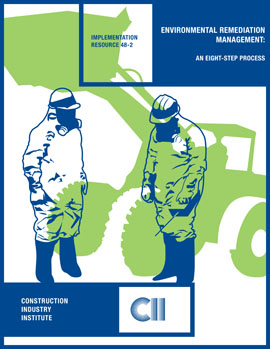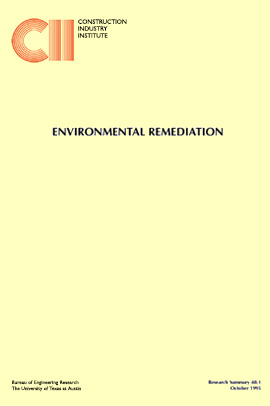
Environmental Remediation Management: An Eight-Step Process
Environmental remediation projects differ significantly in several respects from conventional construction projects. Foremost are the goals of remediation projects: to perform a cost-effective clean-up, to comply with regulations, to uphold corporate reputation, and to reduce liabilities. Other differentiating factors include the uncertainty in project scope and changing regulatory requirements and interpretations. In addition, technological and financial uncertainties present unique management challenges.
This publication describes an eight-step process for managing environmental remediation that can maximize successes and minimize problems. A separate chapter is devoted to each of the eight steps, and key management issues relevant to each step are highlighted.
Although written primarily for owner managers of remediation projects, the information provided here also is valuable for design and construction contractors involved in remediation. The most important issues and recommendations for managing remediation projects can be summarized as follows:
- Act quickly when potential contamination is identified. Delays only increase the chance that others will dictate the course of the remediation action.
- Be aware of the significant regulatory, budget, and community relations impacts of a remediation project.
- Develop a preliminary remediation plan early in the project and update it continuously as new information is gathered. Planning is essential to control the outcome of the project. Be certain that the plan reflects regulatory requirements, potential remedies, cost, and schedule.
- Consider data quality objectives carefully when planning site characterization.
- Verify the performance of remediation technologies before deciding upon a remedy.
- Establish unambiguous goals for site clean-up with regulatory agencies.
- Produce a cost-effective remedial design that will satisfy all remediation requirements.
- Provide cost and schedule contingencies, which are typically larger than those required for conventional construction projects.
- Recognize the uncertainty in site conditions, technology performance, and regulatory issues, and plan accordingly. Negotiate contracts that share risks appropriately.
- Plan for a monitoring program that may be required to last from a few months to 30 years or until final closure is granted from the regulators.
Major remediation projects, because of their complexity, must use a team approach. Key team members include project managers, environmental professionals, legal counsel, project controls specialists, and fully qualified remedial design and construction contractors. The owner’s business unit can provide the team with overall direction for long-term site strategy. Remediating contaminated sites can be a costly and time-consuming process. Proactive owner management is essential to a successful remediation project. The eight-step process presented in this publication is a tool that can help in achieving that success.
Identifies the critical steps that should be followed in the remediation process, and the key management issues and actions that should be taken at each step to achieve the goals of the remediation project. Each of the 8 steps includes key management issues, activities, and concepts needed for that step.



